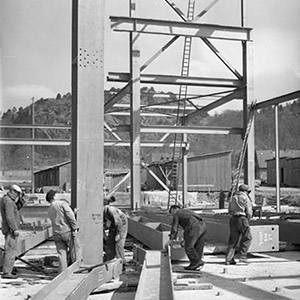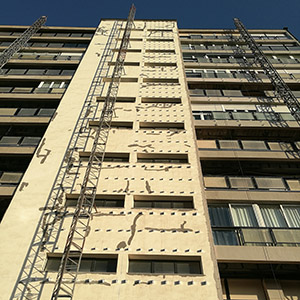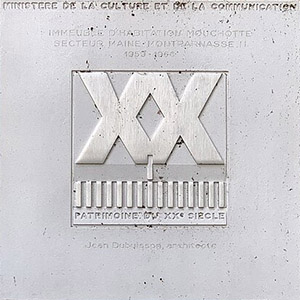Research Lines
Architecture of the 20th Century
Construction of the Architecture of the 20th Century
Deterioration and deficiency of the Architecture of the 20th Century
Intervention and reparation of the Architecture of the 20th Century
Digitalisation of the Architecture of the 20th Century
Cataloguing and inventorying of the Architecture of the 20th Century
Architecture of the 20th Century

The research line will be focused on the study and documentary compilation related to twentieth-century architects. In addition to the search for projects, photographs and technical documents of those works built in the Basque Country during the twentieth century, the aim will be to complete the biographies of those architects who have often been forgotten, as well as their works, putting them in context and relating them to the main trends of their time.
Construction of the Architecture of the 20th Century

Construction systems underwent an unprecedented evolution throughout the twentieth century, in which technological advances were, quantitatively and qualitatively, far superior to those achieved during the preceding centuries. It is true that the diversity and complexity of the architectural ensemble in our society is all diverse and extremely complex. It is just as true that the architectural heritage of the twenties also presents specific characteristics from a technological point of view, since it is associated with the industrial production systems of the twentieth and nineteenth centuries.
This research line is dedicated to the study of the construction systems used during the twentieth century, either to build collective housing or for any other type and program. It is considered a key line, given that an intervention on the built heritage without previously studying not only the constructive characteristics of the building object of intervention, but also the entire technological, industrial and social context in which it was developed, is doomed to failure.
Deterioration and deficiency of the Architecture of the 20th Century

A construction system is characterized, among other things, by the way in which it deteriorates. It is a characteristic inherent to its nature, which depends on the materials of which it is composed, their rheological characteristics, the relationship between their elements, their protection and their exposure. As far as twentieth-century architecture is concerned, its deterioration acquires greater complexity, given the multiplicity of materials, elements and products that converge in the same system.
On the other hand, it is clear that issues such as energy savings or greenhouse gas emission levels have historically been alien to building technology. However, as a result of the adoption of new comfort standards and faced with the challenge of reducing CO2 emissions, the building in general, and the residential stock built during the twenties in particular, has proved to be deficient. The line seeks, therefore, to obtain the ranges that in terms of demand and emissions each of the residential types of the twentieth century present, since their energy characterization will be very useful when undertaking rehabilitation strategies.
Intervention and reparation of the Architecture of the 20th Century

Of the international documents related to cultural and architectural heritage, those that have the greatest impact on the intervention on the heritage of the twenties are the Charter of Cadiz and the Madrid Document, which promulgates the Criteria for the Conservation of the Architectural Heritage of the Twentieth Century.
The Cádiz Charter (2007) states forcefully that the disappearance of the buildings of the Modern Movement is an indicative testimony to the cultural and environmental failure of the countries and cities that allow it, calling attention to four aspects considered essential for the conservation of contemporary built heritage: firstly, to prevent the architecture of the twenties from being distorted as a result of the intervention; secondly, the conservation of those urban and landscape environments produced by the modern movement; thirdly, the conservation of the buildings of the Modern Movement, and finally, the preservation of the construction techniques linked to the industrial buildings of the Modern Movement.
The line will provide a way for research about conservation techniques in buildings of the twenties, understood as all those actions, beyond normal maintenance, whose purpose is to maintain the characteristics of all its components.
Second, it will bring new knowledge about rehabilitation. The various intervention strategies on non-protected collective housing will be studied, either in order to optimize its energy performance, or to adapt and expand a residential type that has become obsolete.
It will also deal with the maintenance of the architecture of the twenties, understood as any action on an architectural element, whose purpose is to conserve or maintain the characteristics of all its components, whether they are essential or secondary.
Finally, restoration strategies will be developed aimed at restoring the original characteristics of the buildings, lost or denatured for one reason or another. In the case of twentieth-century architecture, the technical solutions are complex: the diversity of techniques used in its construction; the experimental characteristics of some of the systems used, many of which have ceased to be produced, or the reduced durability of some materials, make it necessary to apply specific strategies, as well as the development of critical and operational tools that, in general, are not part of the know-how of the agents on whom the responsibility of restoration falls.
Digitalisation of the Architecture of the 20th Century

The line will be dedicated to digitalization, which is profoundly changing our cultural experience, not only in terms of production and dissemination, but also in terms of participation, creation and learning in the knowledge society.
As far as architecture is concerned, the European directive for public procurement (2014/24/EU) dictates that public heritage rehabilitation works must be tendered based on electronic building design tools. Because of this, administrations and agents involved in the management of built heritage demand solvent tools, given the enormous amount of information that must be handled. To do this, it is necessary to have tools that make it possible to collect, compare, share and manage all the available information regarding the geometry and state of conservation of buildings.
Such data include, but are not limited to, the geometry of the buildings, thematic and historical content, construction information, previous phases of intervention, detected alterations and information on maintenance or restoration activities. On the other hand, Law 9/2022, of June 14, 2022, on the Quality of Architecture, echoing Directive 2014/24/EU, says that the administration will promote the use of specific electronic tools in public sector projects, such as digital modelling methodologies for building information (BIM) or similar and the incorporation of innovative techniques.
The line will be dedicated to the application of BIM to the architecture of the twenties, as well as to the optimization of its application. The research will follow the guidelines established by the group itself in order to design an innovative methodology for the analysis, processing and management of information based on an as-built 3D graphic model, complemented by a specialized database: historical, archaeological, architectural, alteration data, etc.; all through the use of photogrammetry or 3D scanning, methods that are especially useful for historic buildings, given the irregularities and alterations to which they are subjected.
The line will also study the application, in the management of the architectural heritage of the twentieth century, of Geographic Information Systems (GIS), which allow the integration of the multiple ways of collecting reality and interrelating them with each other. A GIS can simultaneously accommodate cartography, whether topographic or thematic, satellite imagery, any database, no matter how complex, or photography, as long as all this information is properly georeferenced. GIS contemplates reality disaggregated into different layers of information that overlap. This requires a process of structuring the data in such a way that they are susceptible to forming levels of information organized according to their thematic contents. It will also simultaneously handle thematic maps containing vegetation, soils, relief, geology and others.
Cataloguing and inventorying of the Architecture of the 20th Century

Cataloguing consists of identifying, describing and systematizing the corpus of architectural heritage. This activity results in the drafting of catalogues and municipal regulations for their integration into the Register of Basque Cultural Heritage and the Register of Cultural Assets of Basic Protection of the Basque Government. It is also a fundamental basis for the development of Rehabilitation Programmes for real estate and urban spaces, promoted by city councils and local entities that establish rules for their protection. The line will be dedicated to the cataloguing of buildings and ensembles of the twenties, incorporating digital techniques such as 3D scanning and delving into the justification of such cataloguing through comparative and contextualized historical study.
As far as the inventory is concerned, the first requirement to be able to plan the protection and promotion of the architectural heritage is the identification of the buildings susceptible to protection through the carrying out of a general census of them. The first attempts to undertake a comprehensive inventory of the architectural heritage in the Basque Country date back to 1978. Since then, there have been multiple initiatives promoted by different public institutions, with a tendency to expand the typological varieties that are the object of attention. In this respect, twentieth-century architecture has been gaining recognition, coinciding precisely with the end of the century, so that hundreds of residential, industrial or endowment buildings have come to be considered worthy of being cared for.
